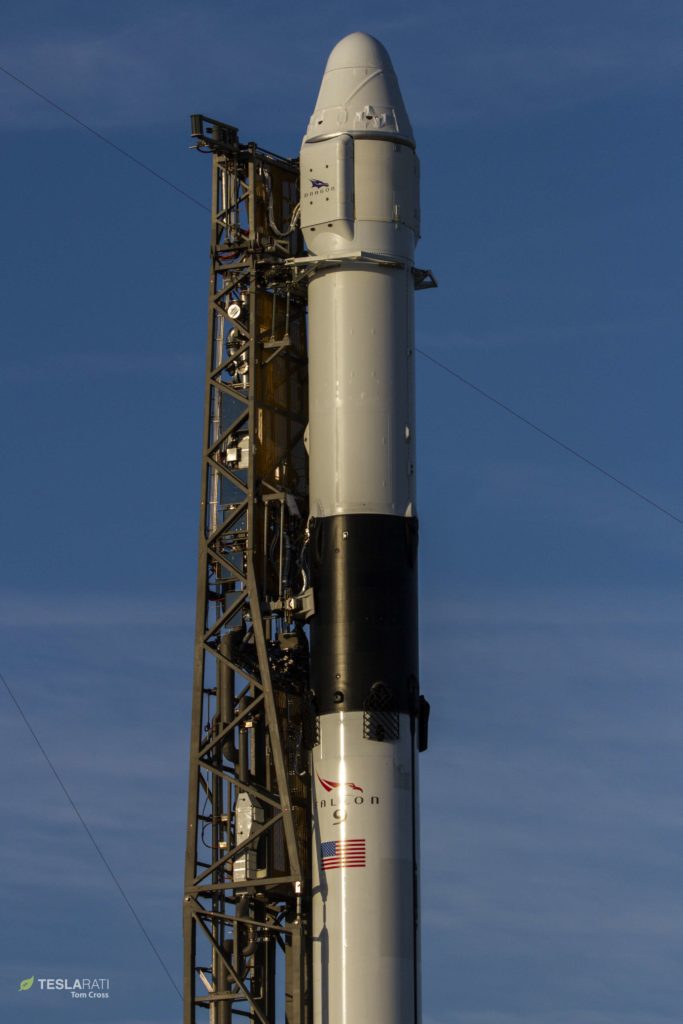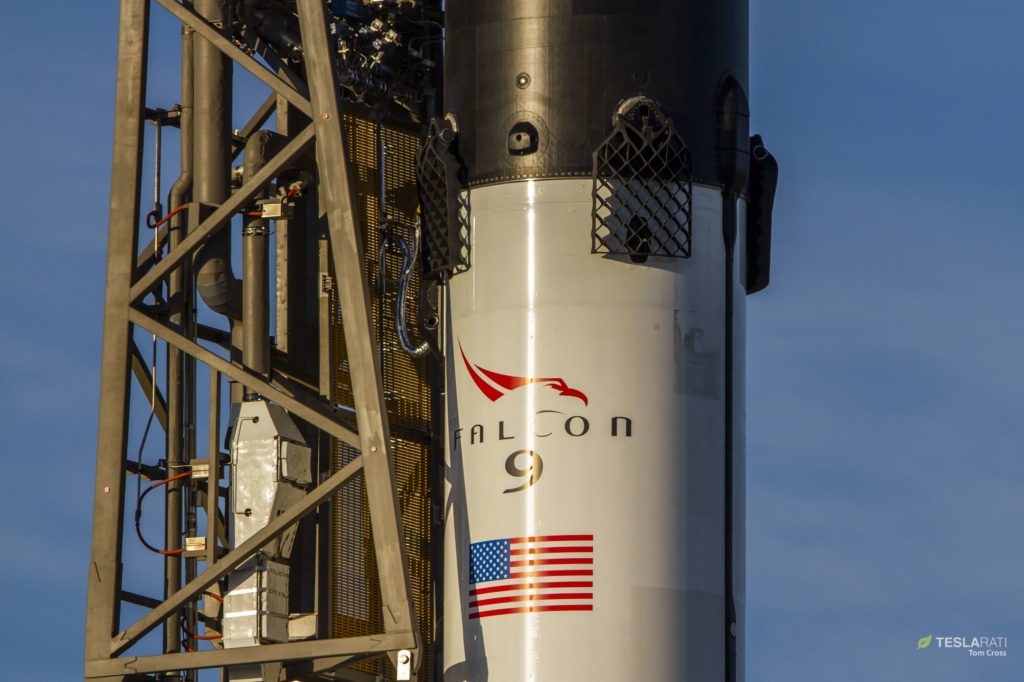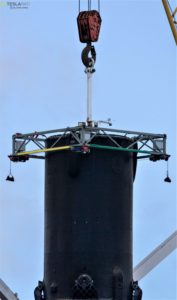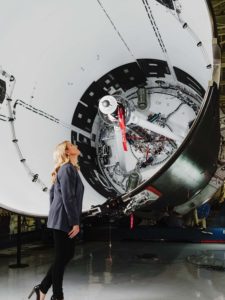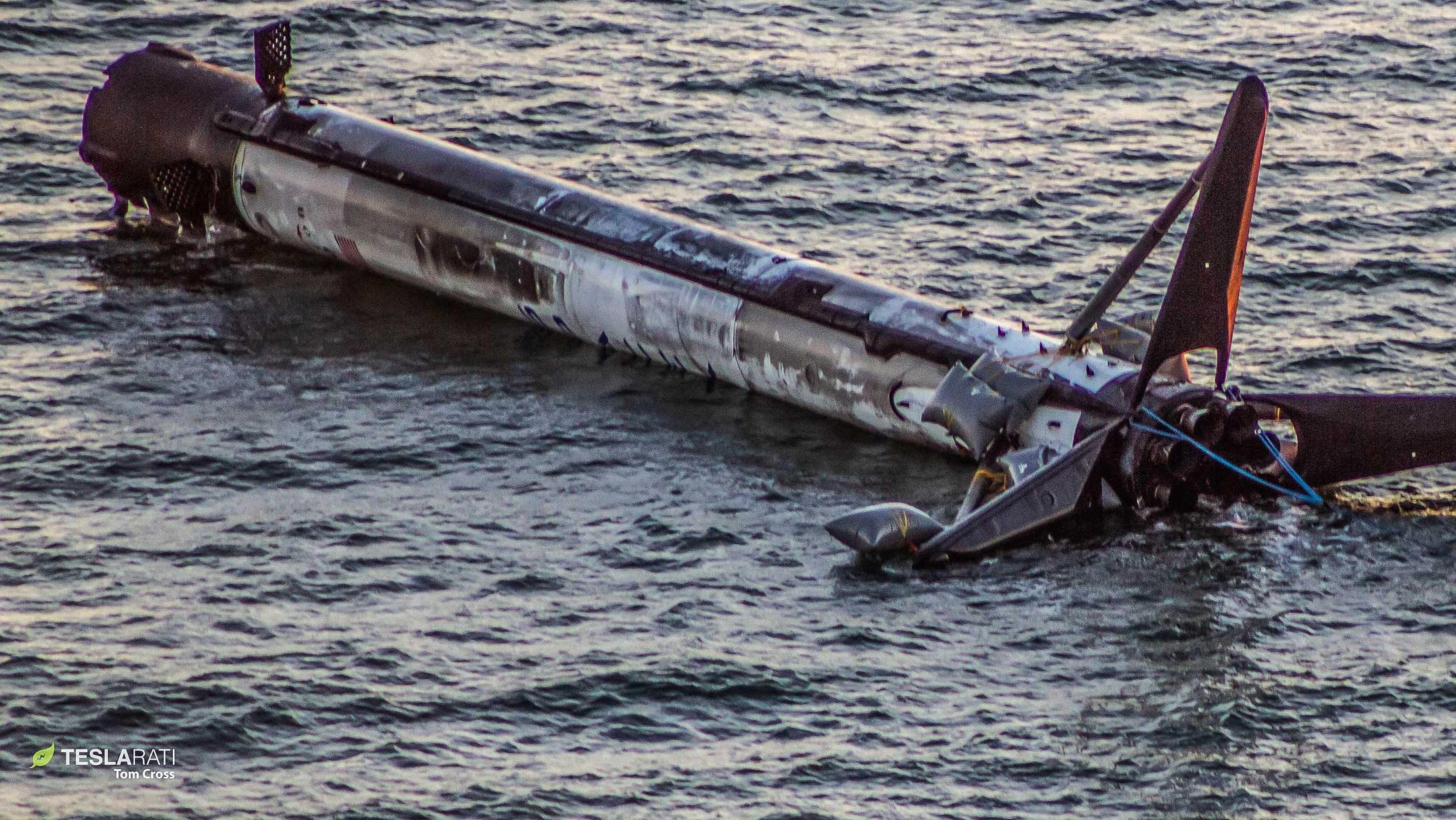

SpaceX
SpaceX’s first Falcon 9 Block 5 booster casualty battered but still intact in aerial photos
Shortly after successfully sending a reused Cargo Dragon spacecraft on its way towards the International Space Station (ISS), SpaceX Falcon 9 Block 5 booster B1050 experienced an anomaly with its grid fins during a planned landing, resulting in a shockingly soft (but unintentional) landing just off the Florida coast.
By some minor miracle, the drastically off-nominal loads experienced by the booster during its unintended departure from controlled flight somehow did not rise to the bar of structural failure. Nevertheless, now floating a handful of miles east of Port Canaveral’s mouth, B1050 did not make it through the ordeal unscathed.
https://twitter.com/_TomCross_/status/1070742919986991107
A little more than 24 hours after the booster found itself floating sideways in the Atlantic Ocean, B1050 had floated a solid ten miles south of its original position into waters and airspace that no longer fell under the purview of Cape Canaveral Air Force Station, technically a military outpost. As the captains of tugboat Eagle and SpaceX support vessel GO Quest discussed the logistics of returning the booster to port with the local harbormaster and US Coast Guard, Teslarati photographer Tom Cross chartered a local helicopter to get a slightly better view of the waterlogged rocket and its ad-hoc recovery operations.
A casualty of war (with the air)
Second only to the fact that the booster appears to be in disproportionately good shape considering the circumstances, by far the most noteworthy feature of the newest addition to SpaceX’s marine fleet is the sheer damage suffered by B1050’s interstage, the black carbon fiber composite structure that topsFalcon 9 Block 5 boosters and hosts its grid fins and stage separation mechanism.
Revealed from an aerial perspective, it almost looks as if one side of the composite cylinder was smashed with a giant hammer, tearing off at least 20% of the entire interstage – including one of four titanium grid fins – while leaving another large segment hanging on by only partially-figurative carbon fiber threads.
- Falcon 9 B1050 is seen here shortly before launch with an intact interstage. (Tom Cross)
- B1050 viewed from Cocoa Beach. (Tom Cross)
- Falcon 9 B1050’s interstage, or what’s left of it. (Tom Cross)
- RIP grid fin. (Tom Cross)
It’s not 100% clear why B1050’s interstage was so readily destroyed but a narrative can certainly be drawn from the current public record. After its grid fins lost hydraulic power and became stuck at an extreme angle, B1050 almost immediately lost control and began rapidly and quite brutally spinning and flailing, tossed around as it hurtled through the air at supersonic speeds. Being a predominately smooth cylinder, Falcon 9’s first stage is inherently prone to rotation in the presence of high-velocity air currents, which is why its grid fins are an absolute necessity for maintaining control authority during in-atmosphere “flights”.
Engines stabilized rocket spin just in time, enabling an intact landing in water! Ships en route to rescue Falcon. pic.twitter.com/O3h8eCgGJ7
— Elon Musk (@elonmusk) December 5, 2018
In a show that will turn the stomach of anyone familiar with a rocket’s typically narrow load tolerances, Falcon 9 B1050 experienced extreme aerodynamic stresses during the worst of its uncontrolled tumble, to the extent that the entire booster and interstage can be seen visibly twisting at least 5 degrees left and right from the perspective of an onboard camera. In the video above, focus on the center of Falcon 9’s grid fins during the first and last 5-10 seconds to properly visualize the extreme forces at play.
It might look fairly innocent to the untrained eye, but keep in mind that Falcon 9’s interstage is no more than a couple of inches thick and is absolutely massive, stretching 3.7m (~12 ft) in diameter. Perhaps even more importantly, the damage to the interstage has almost without a doubt rendered it unusable from the perspective of SpaceX’s established methods of safely moving and manipulating Falcon 9 boosters.
- Technicians attach an older interstage-grabber to lift B1046 after its first recovery. (Tom Cross)
- One of SpaceX’s East Coast interstage jigs is pictured here atop B1049. (Tom Cross)
- A Falcon 9 Block 5 booster bares its interstage and pusher rod, offering a perfect illustration of its scale. (Bloomberg)
All of those methods rely on adapters that attach to the interstage to lift the rocket vertically or support part of its ~30-ton dry mass horizontally. Lacking a sound interstage, it’s now entirely unclear how SpaceX might go about getting B1050 onto land without damaging it further. In simpler terms, this bodes very, very badly for any plans to safely reuse B1050 in the near (or distant) future. After suffering loads that severely weakened and ultimately tore its interstage to pieces, it’s reasonable to assume that the rest of the rocket’s lithium-aluminum propellant tanks experienced stresses that are at least roughly comparable.
If that’s the case, perhaps the only real hope for B1050’s ‘reuse’ will be the recovery of certain subcomponents and miscellaneous parts that may have made it through the ordeal unscathed or with only minor damage. The three remaining titanium grid fins are a guaranteed recovery, while COPVs, cold gas thrusters, avionics boxes, and maybe even some of its nine Merlin 1D engines could be salvageable with some level of refurbishment.
In the meantime, the tentative plan right now is to two B1050 into Port Canaveral sometime after dawn tomorrow, either ending up at drone ship OCISLY’s berth or another less-developed section of the port.
For prompt updates, on-the-ground perspectives, and unique glimpses of SpaceX’s rocket recovery fleet check out our brand new LaunchPad and LandingZone newsletters!
News
SpaceX launches Ax-4 mission to the ISS with international crew
The SpaceX Falcon 9 launched Axiom’s Ax-4 mission to ISS. Ax-4 crew will conduct 60+ science experiments during a 14-day stay on the ISS.

SpaceX launched the Falcon 9 rocket kickstarting Axiom Space’s Ax-4 mission to the International Space Station (ISS). Axiom’s Ax-4 mission is led by a historic international crew and lifted off from Kennedy Space Center’s Launch Complex 39A at 2:31 a.m. ET on June 25, 2025.
The Ax-4 crew is set to dock with the ISS around 7 a.m. ET on Thursday, June 26, 2025. Axiom Space, a Houston-based commercial space company, coordinated the mission with SpaceX for transportation and NASA for ISS access, with support from the European Space Agency and the astronauts’ governments.
The Ax-4 mission marks a milestone in global space collaboration. The Ax-4 crew, commanded by U.S. astronaut Peggy Whitson, includes Shubhanshu Shukla from India as the pilot, alongside mission specialists Sławosz Uznański-Wiśniewski from Poland and Tibor Kapu from Hungary.
“The trip marks the return to human spaceflight for those countries — their first government-sponsored flights in more than 40 years,” Axiom noted.
Shukla’s participation aligns with India’s Gaganyaan program planned for 2027. He is the first Indian astronaut to visit the ISS since Rakesh Sharma in 1984.
Axiom’s Ax-4 mission marks SpaceX’s 18th human spaceflight. The mission employs a Crew Dragon capsule atop a Falcon 9 rocket, designed with a launch escape system and “two-fault tolerant” for enhanced safety. The Axiom mission faced a few delays due to weather, a Falcon 9 leak, and an ISS Zvezda module leak investigation by NASA and Roscosmos before the recent successful launch.
As the crew prepares to execute its scientific objectives, SpaceX’s Ax-4 mission paves the way for a new era of inclusive space research, inspiring future generations and solidifying collaborative ties in the cosmos. During the Ax-4 crew’s 14-day stay in the ISS, the astronauts will conduct nearly 60 experiments.
“We’ll be conducting research that spans biology, material, and physical sciences as well as technology demonstrations,” said Whitson. “We’ll also be engaging with students around the world, sharing our experience and inspiring the next generation of explorers.”
SpaceX’s Ax-4 mission highlights Axiom’s role in advancing commercial spaceflight and fostering international partnerships. The mission strengthens global space exploration efforts by enabling historic spaceflight returns for India, Poland, and Hungary.
News
Starlink Cellular’s T-Mobile service to grow with third-party app data
From Oct 2025, T-Satellite will enable third-party apps in dead zones! WhatsApp, X, AccuWeather + more coming soon.

Starlink Cellular’s T-Mobile service will expand with third-party app data support starting in October, enhancing connectivity in cellular dead zones.
T-Mobile’s T-Satellite, supported by Starlink, launches officially on July 23. Following its launch, T-Mobile’s Starlink Cellular service will enable data access for third-party apps like WhatsApp, X, Google, Apple, AccuWeather, and AllTrails on October 1, 2025.
T-Mobile’s Starlink Cellular is currently in free beta. T-Satellite will add MMS support for Android phones on July 23, with iPhone support to follow. MMS support allows users to send images and audio clips alongside texts. By October, T-Mobile will extend emergency texting to all mobile users with compatible phones, beyond just T-Mobile customers, building on its existing 911 texting capability. The carrier also provides developer tools to help app makers integrate their software with T-Satellite’s data service, with plans to grow the supported app list.
T-Mobile announced these updates during an event celebrating an Ookla award naming it the best U.S. phone network, a remarkable turnaround from its last-place ranking a decade ago.
“We not only dream about going from worst to best, we actually do it. We’re a good two years ahead of Verizon and AT&T, and I believe that lead is going to grow,” said T-Mobile’s Chief Operating Officer Srini Gopalan.
T-Mobile unveiled two promotions for its Starlink Cellular services to attract new subscribers. A free DoorDash DashPass membership, valued at $10/month, will be included with popular plans like Experience Beyond and Experience More, offering reduced delivery and service fees. Meanwhile, the Easy Upgrade promotion targets Verizon customers by paying off their phone balances and providing flagship devices like the iPhone 16, Galaxy S25, or Pixel 9.
T-Mobile’s collaboration with SpaceX’s Starlink Cellular leverages orbiting satellites to deliver connectivity where traditional networks fail, particularly in remote areas. Supporting third-party apps underscores T-Mobile’s commitment to enhancing user experiences through innovative partnerships. As T-Satellite’s capabilities grow, including broader app integration and emergency access, T-Mobile is poised to strengthen its lead in the U.S. wireless market.
By combining Starlink’s satellite technology with strategic promotions, T-Mobile is redefining mobile connectivity. The upcoming third-party app data support and official T-Satellite launch mark a significant step toward seamless communication, positioning T-Mobile as a trailblazer in next-generation wireless services.
News
Starlink expansion into Vietnam targets the healthcare sector
Starlink aims to deliver reliable internet to Vietnam’s remote clinics, enabling telehealth and data sharing.

SpaceX’s Starlink expansion into Vietnam targets its healthcare sector. Through Starlink, SpaceX seeks to drive digital transformation in Vietnam.
On June 18, a SpaceX delegation met with Vietnam’s Ministry of Health (MoH) in Hanoi. SpaceX’s delegation was led by Andrew Matlock, Director of Enterprise Sales, and the discussions focused on enhancing connectivity for hospitals and clinics in Vietnam’s remote areas.
Deputy Minister of Health (MoH) Tran Van Thuan emphasized collaboration between SpaceX and Vietnam. Tran stated: “SpaceX should cooperate with the MoH to ensure all hospitals and clinics in remote areas are connected to the StarLink satellite system and share information, plans, and the issues discussed by members of the MoH. The ministry is also ready to provide information and send staff to work with the corporation.”
The MoH assigned its Department of Science, Technology, and Training to work with SpaceX. Starlink Vietnam will also receive support from Vietnam’s Department of International Cooperation. Starlink Vietnam’s agenda includes improving internet connectivity for remote healthcare facilities, developing digital infrastructure for health examinations and remote consultations, and enhancing operational systems.
Vietnam’s health sector is prioritizing IT and digital transformation, focusing on electronic health records, data centers, and remote medical services. However, challenges persist in deploying IT solutions in remote regions, prompting Vietnam to seek partnerships like SpaceX’s.
SpaceX’s Starlink has a proven track record in healthcare. In Rwanda, its services supported 40 health centers, earning praise for improving operations. Similarly, Starlink enabled remote consultations at the UAE’s Emirati field hospital in Gaza, streamlining communication for complex medical cases. These successes highlight Starlink’s potential to transform Vietnam’s healthcare landscape.
On May 20, SpaceX met with Vietnam’s Ministry of Industry and Trade, announcing a $1.5 billion investment to provide broadband internet, particularly in remote, border, and island areas. The first phase includes building 10-15 ground stations across the country. This infrastructure will support Starlink’s healthcare initiatives by ensuring reliable connectivity.
Starlink’s expansion in Vietnam aligns with the country’s push for digital transformation, as outlined by the MoH. By leveraging its satellite internet expertise, SpaceX aims to bridge connectivity gaps, enabling advanced healthcare services in underserved regions. This collaboration could redefine Vietnam’s healthcare infrastructure, positioning Starlink as a key player in the nation’s digital future.
-

 Elon Musk3 days ago
Elon Musk3 days agoTesla investors will be shocked by Jim Cramer’s latest assessment
-

 News1 week ago
News1 week agoTesla Robotaxi’s biggest challenge seems to be this one thing
-

 News2 weeks ago
News2 weeks agoTexas lawmakers urge Tesla to delay Austin robotaxi launch to September
-

 Elon Musk2 weeks ago
Elon Musk2 weeks agoFirst Look at Tesla’s Robotaxi App: features, design, and more
-

 Elon Musk2 weeks ago
Elon Musk2 weeks agoxAI’s Grok 3 partners with Oracle Cloud for corporate AI innovation
-

 News2 weeks ago
News2 weeks agoSpaceX and Elon Musk share insights on Starship Ship 36’s RUD
-

 News2 weeks ago
News2 weeks agoWatch Tesla’s first driverless public Robotaxi rides in Texas
-

 News2 weeks ago
News2 weeks agoTesla has started rolling out initial round of Robotaxi invites

